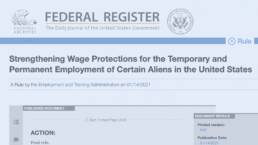On January 14, 2021, the U.S. Department of Labor (DOL) published a final rule, Strengthening Wage Protections for the Temporary and Permanent Employment of Certain Aliens in the United States, changing how wage levels are computed under the DOL’s four-tier wage structure. The January 14, 2021 rule is a revised version of a similar DOL rule, published October 8, 2020, that was struck down by three federal district courts on procedural grounds. Like the invalidated October 8, 2020 rule (“Original Rule”), the January 14, 2021 rule (“Final Rule”) seeks to lift wages for H-1B, E-3, and H-1B1 nonimmigrant cases and the PERM labor certification program.
What will DOL’s Final Rule do?
The Final Rule will increase the Occupational Employment Statistics (OES) wage minimums in each of the four levels currently used to calculate a foreign worker’s prevailing wage. Once the Final Rule is effective, OES wage minimums will be raised as such:
- Level 1 (entry level): The wage minimum for entry-level workers will increase from 17% of the average wage made for that occupation to 35% of the average wage made for such occupation.
- Level 2: The wage minimum for skill level 2 workers will increase from 34% of the average wage made for that occupation to 53% of the average wage made for such occupation.
- Level 3: The wage minimum for skill level 3 workers will increase from 50% of the average wage made for that occupation to 72% of the average wage made for such occupation.
- Level 4 (highest skill level): The wage minimum for skill level 4 workers will increase from 67% of the average wage made for that occupation to 90% of the average wage made for such occupation.
These increases will essentially raise OES wage minimums to reflect the wages currently made by foreign workers in the level immediately above their current skill level (i.e., entry-level workers will be making what skill level 2 workers make now). Although the increases are significant, they are lower than those proposed in the DOL’s Original Rule published under the Trump Administration. The DOL adjusted the wage increases outlined in the Original Rule after receiving comments from employers insisting they were “arbitrary and unsustainable,” especially given the immediate effective date of the Original Rule. The DOL contends that the adjusted increases in the Final Rule “better reflect the actual wages earned by U.S. workers similarly employed to foreign workers.”
To give employers time to meet the wage increases, the Final Rule provides two phase-in periods that allow for gradual adjustment of foreign workers’ pay. The first wage period—July 1, 2021, to July 1, 2022—applies to all new job opportunities. On July 1, 2021, the entry-level wage will increase from the current 17th percentile to 90% of the final wage level (i.e., about 90% of the prescribed 35th percentile wage rate) and the level 4 wage will increase from the current 67th percentile to 90% of the final wage level (i.e., about 90% of the prescribed 90th percentile wage rate). On July 1, 2022, the wage levels will increase again to meet the new minimums, at which point the transition to the new wage structure will be complete for those cases.
The second period—July 1, 2022, to July 1, 2024—applies to job opportunities where an employer will fill a position with a foreign worker eligible for extension of their H-1B status or on track to achieve lawful permanent resident (LPR) status. From July 1, 2021 through June 30, 2022 the prevailing wage will be 85% of the final wage levels; from July 1, 2022 through June 30, 2023 the prevailing wage will be 90% of the final wage levels; and from July 1, 2023 through June 30, 2024 the prevailing wage will be 95% of the final wage levels. By July 2024, all foreign workers on track to receive LPR status or in pursuit of H-1B job opportunities will be subject to the Final Rule’s prescribed minimums.
When will the Final Rule be effective?
The Final Rule was originally scheduled to go into effect on March 15, 2021. Because the Final Rule was published before the change in administration on January 20, 2021, it is subject to President Biden’s Memorandum, Regulatory Freeze Pending Review, which encourages agencies to postpone the effective dates of all rules that were published in the Federal Register, but have not yet taken effect, for 60 days. In line with Biden’s Memorandum, the DOL has proposed delaying the effective date of the Final Rule to May 14, 2021, with wage increases to begin taking effect on July 1, 2021. The DOL initiated a 15-day comment period on February 1, 2021 calling for comments from interested parties regarding the delayed effective date. The DOL is currently only seeking comments regarding the proposed delay, not the substance of the Final Rule.
What will happen next?
Critics of the new wage increases will likely have to sue the DOL to invalidate the Final Rule. As the H-1B category has historically been attacked by members of both the Republican party and certain subsects of the Democratic party for “taking jobs away from U.S. workers,” it is not clear how the Biden Administration will respond to anticipated attacks on the Final Rule. In the meantime, U.S. employers should be prepared to pay the increased wages if they plan to hire foreign workers.
Berardi Immigration Law will be sure to keep an eye out for more important updates!
Ready to have Berardi on your side?
Whether you’re a business looking to hire or a professional hoping to relocate, immigration law can be complicated. But you don’t have to do it alone. Put our experience to work for you.



